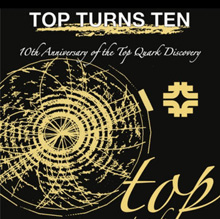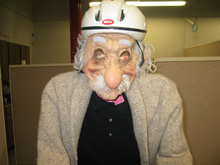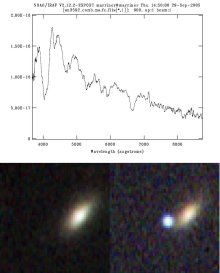 | Wednesday, October 5, 2005 |
|
Wednesday, October 5 Thursday, October 5 |
|
Extended Forecast |
Secon Level 3 |
|
Wednesday, October 5 - Portabello Harvest Grain - Santa Fe Chicken Quesadilla - Garlic Herb Roasted Pork - Beef Stroganoff - Maryland Crab Salad - Meatlover's Pizza - Pesto Shrimp Linguini w/Leeks and Tomatoes The Wilson Hall Cafe accepts Visa, Master Card, Discover and American Express at Cash Register #1. |
|
Wednesday, October 5
Thursday, October 6
Chez Leon Menu |
| Fermilab Today is online at: http://www.fnal.gov/today/ Send comments and suggestions to today@fnal.gov Fermilab Today archive Hurricane Relief Page Fermilab Today PDF Version Fermilab Result of the Week archive Fermilab Safety Tip of the Week archive Linear Collider News archive Fermilab Today classifieds Subscribe/Unsubscribe to |
| Congratulations Fermilab! |
| Fermilab has set a world record for peak luminosity of a hadron collider! Operations established store 4431 at 9:11 a.m. yesterday, October 4, with an initial luminosity, or brightness, of 141E30 cm-2sec-1. This record exceeds the previous Tevatron record by almost 8 percent, and it exceeds the world record for peak luminosity of a hadron collider achieved 23 years ago by the ISR proton-proton collider at CERN. The ISR achieved a peak luminosity of 140E30 cm-2sec-1 at a collision energy of 62 GeV. The Tevatron produces collisions between protons and antiprotons at a collision energy of 1960 GeV. The peak luminosity of the Tevatron has greatly increased since Fermilab began Run II in March 2001, and Fermilab expects to improve the Tevatron peak luminosity even further. |
| Celebration to Honor 10th Anniversary of Top Quark | |
|
It'll be a birthday party to remember; a celebration of the discovery of the top quark at Fermilab, a look at how that particle's "birth" has altered the physics field and a day to honor those who delivered it. The Top Turns Ten celebration, paying tribute to the now decade-old discovery, will be held from 1-5 p.m. on Friday, October 21 in Ramsey Auditorium and the Atrium.
A host of symposium speakers, including former Fermilab Director John Peoples and University of Pennsylvania theorist Paul Langacker, will address the challenges building up to the discovery, the triumph that ensued and how it has changed particle physics. "It's an afternoon of celebration, story-telling, and recollections," said Top Turns Ten committee chairman Chris Quigg, of the Theoretical Physics Department. "The top discoverers did the nearly impossible." CDF and DZero scientists, who were among the experimental physicists representing 74 institutions from around the world at the time of the discovery, will share their thoughts during the second half of the symposium. But the 10-year anniversary celebration goes beyond the experimental collaborations. Posters will depict the involvement of groups throughout the laboratory, from Business Services to the Accelerator Division. The posters will be on display for about two weeks in the Atrium starting October 21.
Jeff Appel, Assistant Director for program planning, said he encourages the whole Fermilab community to participate in the event. "It was an exciting thing even if you didn't have any involvement in the discovery," he said. "One hopes to transmit that excitement to the people who weren't here then."
|
|
From PhysOrg.com, October 4, 2005: Researchers transform the properties of matter with tunable quantum dots Researchers at the University of Pennsylvania may not have turned lead into gold as alchemists once sought to do, but they did turn lead and selenium nanocrystals into solids with remarkable physical properties. In the October 5 edition of Physical Review Letters, online now, physicists Hugo E. Romero and Marija Drndic describe how they developed am artificial solid that can be transformed from an insulator to a semiconductor.
The Penn physicists are among many modern researchers who have been experimenting with a different way of transforming matter through artificial solids, formed from closely packed nanoscale crystals, also called "quantum dots."
|
| SDSS-II Supernova Survey Launched
|
||
|
||
|
In July of this year, the Sloan
Digital Sky Survey began a 3-year extension known as SDSS-II. The
Supernova Survey is an important new component of SDSS-II. A
supernova is an explosion of a star that leaves behind a neutron star,
black hole, or no remnant at all. The energy released by the explosion
can make a supernova outshine all the other stars in its
galaxy for a period of a few weeks.
Depending on the type and chemical composition of the star, the explosions happen in different ways. The SDSS is mainly after the so-called "Type Ia" supernovae, which act as standard candles: at maximum light, all Type Ia supernovae have about the same intrinsic luminosity, about 1036 watts. By comparing the apparent brightness of different supernovae, we can measure their relative distances from Earth. By plotting supernova distances against their redshifts (the shift in the frequency of light due to the expansion of the universe), we can measure the history of the cosmic expansion rate. Interest in this technique heated up in 1998, when two teams of astronomers announced that their supernova data indicated that the expansion of the universe is speeding up instead of slowing down. This implies that the universe is filled with a new form of "dark energy" with properties completely unlike ordinary baryonic or even dark matter. This picture was subsequently corroborated by observations of the cosmic microwave background radiation and of the large-scale distribution of galaxies by the SDSS and other surveys. The SDSS survey telescope and camera have the ideal combination of sensitivity and large area coverage to find large numbers of supernovae in the previously unexplored redshift range 0.1-0.3, where supernovae are too faint to be found by smaller telescopes and too sparse to be seen by larger telescopes with smaller fields of view. The first of three annual supernova data runs is taking place from September through November of this year. Every other night, the survey camera scans the same part of the sky, covering about 300 square degrees in total. A dedicated image subtraction pipeline compares the new data to older observations of the same part of the sky, to quickly identify new, bright objects as supernova candidates. The promising candidates are then observed spectroscopically with several telescopes around the world (in New Mexico, Texas, Arizona, Hawaii, and the Canary Islands) to confirm that they are indeed Type Ia supernovae and to measure their redshifts. Although the first week of the run was stymied by poor weather, conditions subsequently improved dramatically, and the SDSS researchers have so far identified 36 new type Ia supernovae. Over the course of the next three years, the SDSS expects to measure distances to on the order of 200 type Ia supernovae and thereby make an important contribution to the study of dark energy. The Supernova Survey is being carried out by an international team within the SDSS-II collaboration, including scientists from Fermilab, the University of Chicago, the University of Washington, Stanford and SLAC, the University of Portsmouth, the University of Tokyo, Apache Point Observatory, and the University of Notre Dame. |
|
Lecture: Origami in Art, Science and Technology
Robert J. Lang, Artist & Engineering Consultant, will give a lecture on Friday, October 7 at 8 p.m. in the Ramsey Auditorium. Admission is $5.
Other Upcoming Origami Lectures Upcoming classes:
October 11: Excel Advanced
Dine Out for American Hurrincane Victims
|


